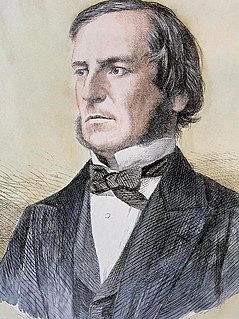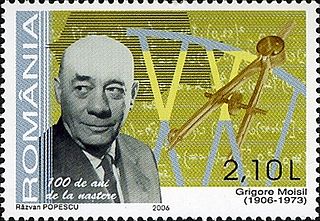Related Research Articles

In abstract algebra, a Boolean algebra or Boolean lattice is a complemented distributive lattice. This type of algebraic structure captures essential properties of both set operations and logic operations. A Boolean algebra can be seen as a generalization of a power set algebra or a field of sets, or its elements can be viewed as generalized truth values. It is also a special case of a De Morgan algebra and a Kleene algebra.

George Boole was a largely self-taught English mathematician, philosopher and logician, most of whose short career was spent as the first professor of mathematics at Queen's College, Cork in Ireland. He worked in the fields of differential equations and algebraic logic, and is best known as the author of The Laws of Thought (1854) which contains Boolean algebra. Boolean logic is credited with laying the foundations for the information age. Boole maintained that:
No general method for the solution of questions in the theory of probabilities can be established which does not explicitly recognise, not only the special numerical bases of the science, but also those universal laws of thought which are the basis of all reasoning, and which, whatever they may be as to their essence, are at least mathematical as to their form.
In mathematical order theory, an ideal is a special subset of a partially ordered set (poset). Although this term historically was derived from the notion of a ring ideal of abstract algebra, it has subsequently been generalized to a different notion. Ideals are of great importance for many constructions in order and lattice theory.
In mathematics and logic, a Boolean function is a function whose arguments, as well as the function itself, assume values from a two-element set. As a result, it is sometimes referred to as a "switching function".

Marshall Harvey Stone was an American mathematician who contributed to real analysis, functional analysis, topology and the study of Boolean algebras.
In mathematics, a complete Boolean algebra is a Boolean algebra in which every subset has a supremum. Complete Boolean algebras are used to construct Boolean-valued models of set theory in the theory of forcing. Every Boolean algebra A has an essentially unique completion, which is a complete Boolean algebra containing A such that every element is the supremum of some subset of A. As a partially ordered set, this completion of A is the Dedekind–MacNeille completion.
In mathematical logic, a Boolean-valued model is a generalization of the ordinary Tarskian notion of structure from model theory. In a Boolean-valued model, the truth values of propositions are not limited to "true" and "false", but instead take values in some fixed complete Boolean algebra.
A Boolean-valued function is a function of the type f : X → B, where X is an arbitrary set and where B is a Boolean domain, i.e. a generic two-element set,, whose elements are interpreted as logical values, for example, 0 = false and 1 = true, i.e., a single bit of information.
In mathematics and abstract algebra, a Boolean domain is a set consisting of exactly two elements whose interpretations include false and true. In logic, mathematics and theoretical computer science, a Boolean domain is usually written as {0, 1}, or

Grigore Constantin Moisil was a Romanian mathematician, computer pioneer, and member of the Romanian Academy. His research was mainly in the fields of mathematical logic, algebraic logic, MV-algebra, and differential equations. He is viewed as the father of computer science in Romania.
In mathematics and abstract algebra, a relation algebra is a residuated Boolean algebra expanded with an involution called converse, a unary operation. The motivating example of a relation algebra is the algebra 2X² of all binary relations on a set X, that is, subsets of the cartesian square X2, with R•S interpreted as the usual composition of binary relations R and S, and with the converse of R as the converse relation.
Logic is the formal science of using reason and is considered a branch of both philosophy and mathematics. Logic investigates and classifies the structure of statements and arguments, both through the study of formal systems of inference and the study of arguments in natural language. The scope of logic can therefore be very large, ranging from core topics such as the study of fallacies and paradoxes, to specialized analyses of reasoning such as probability, correct reasoning, and arguments involving causality. One of the aims of logic is to identify the correct and incorrect inferences. Logicians study the criteria for the evaluation of arguments.
Boolean algebra is a mathematically rich branch of abstract algebra. Just as group theory deals with groups, and linear algebra with vector spaces, Boolean algebras are models of the equational theory of the two values 0 and 1. Common to Boolean algebras, groups, and vector spaces is the notion of an algebraic structure, a set closed under zero or more operations satisfying certain equations.
In mathematics, a Boolean matrix is a matrix with entries from a Boolean algebra. When the two-element Boolean algebra is used, the Boolean matrix is called a logical matrix.
John Lane Bell is a Canadian philosopher and logician. He is Professor of Philosophy at the University of Western Ontario in Canada. He has made contributions to mathematical logic and philosophy, and is the author of a number of books. His research includes such topics as set theory, model theory, lattice theory, modal logic, quantum logic, constructive mathematics, type theory, topos theory, infinitesimal analysis, spacetime theory, and the philosophy of mathematics. He is the author of more than 70 articles and of 11 books. In 2009, he was elected a Fellow of the Royal Society of Canada.
In mathematics, a Cantor algebra, named after Georg Cantor, is one of two closely related Boolean algebras, one countable and one complete.
In mathematics, a collapsing algebra is a type of Boolean algebra sometimes used in forcing to reduce ("collapse") the size of cardinals. The posets used to generate collapsing algebras were introduced by Azriel Lévy in 1963.
In mathematics and mathematical logic, Boolean algebra is the branch of algebra in which the values of the variables are the truth values true and false, usually denoted 1 and 0 respectively. Instead of elementary algebra where the values of the variables are numbers, and the prime operations are addition and multiplication, the main operations of Boolean algebra are the conjunction (and) denoted as ∧, the disjunction (or) denoted as ∨, and the negation (not) denoted as ¬. It is thus a formalism for describing logical operations in the same way that elementary algebra describes numerical operations.
References
- Koppelberg, Sabine (1993), "Characterizations of Cohen algebras", Papers on general topology and applications (Madison, WI, 1991), Annals of the New York Academy of Sciences, 704, New York Academy of Sciences, pp. 222–237, doi:10.1111/j.1749-6632.1993.tb52525.x, MR 1277859
| This set theory-related article is a stub. You can help Wikipedia by expanding it. |